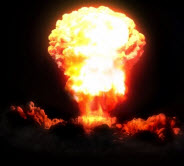EMPS Explained
An electromagnetic pulse (EMP) is a broadband, short burst of electromagnetic energy or radiation. The source of this energy can be natural or man-made. Natural EMP events include lightning, meteoric EMP, electrostatic discharge, and solar storms. Man-made EMP can be either benign or for military use. Non-military examples include the switching action of electrical circuits, gasoline engine ignition systems and power line surges. Military EMP primarily includes nuclear electromagnetic pulse but can also involve non-nuclear electromagnetic pulse weapons.
For our purposes we are most concerned with two categories of EMPS because of their ability to cause severe and long-lasting disruption:
- Solar storms of sufficient strength that they may prove extremely damaging to electronics and electronic distribution systems on earth.
- Nuclear induced EMP resulting from a nuclear explosion at a high altitude (also known as High Altitude Nuclear EMP or HEMP).
EMP Aware focuses on these categories because of the long term catastrophically destructive effect they could have on daily life. Furthermore, this site will most closely discuss the effects of an EMP event on the United States and its citizens.

Solar Storms
A solar storm, also known as a geomagnetic storm or a coronal mass injection, causes a brief disturbance of the earth's magnetosphere. While we have not recently experienced directly on earth solar storms of any magnitude, historically there have been a number of events worthy of mention. The sun goes through different period of active cycles. During the most active times these coronal mass injections can happen several times a day. However the storms, or blasts, are generally weak as compared to the Carrington event of 1859 or the more recent event in 2012. A solar storm will primarily have only the characteristic of a nuclear EMP as defined in the E3 component below.
The most noteworthy solar storm occurred in late August and early September of 1859 and is known as the Carrington super flare or "Carrington event". Numerous sunspots were observed on the sun by amateur astronomers (of whom Richard Carrington was one). In early September one of the largest recorded geomagnetic storms occurred. Aurora were seen around the world and was visible as far from the poles as Cuba and Hawaii. Telegraph systems throughout North America and Europe failed during this event and in some cases shocked the telegraph operators. In June of 2013, Researchers at Lloyd's of London estimated, using data from the Carrington event, that the current cost of a similar event in the United States alone would be between 600 billion and 2.6 trillion dollars. See report Solar Storm Risk to the North American Electric Grid Lloyd's 2013.
Since the Carrington event, a number of solar storms have been reported. A 1989 geomagnetic storm was blamed on the collapse of the Hydro-Quebec power grid in an event that lasted nine hours. The "Bastille Day Event" was a solar storm which occurred in July of 2000. Seventeen major flares were recorded as eruptions on the sun in the latter half of 2003. On July23, 2012, a "Carrington-Class" solar storm occurred with its trajectory missing earth.
 Nuclear Induced EMPs
Nuclear Induced EMPs
A nuclear warhead detonated in the air, some distance above the earth (high-altitude electromagnetic pulse or HEMP), will cause an electromagnetic pulse to be created. The effects of an EMP vary depending on the height at which the event occurs and the strength of the explosion. Numerous high altitude tests have recorded observations of EMPs and their effects. As there is an increasing reliance on electronic devices which are susceptiblee to the effects of an EMP, experts have become much more concerned about the long term damage which could occur in the United States.
A nuclear EMP is typically described as three components dubbed E1, E2, and E3:
- E1 - A brief and intense electromagnetic field which will induce extremely high voltages in electrical conductors. Their rise-time is measured in the range of a fraction of a billionth to a few billionths of a second. Gamma radiation produced from the detonation strips electrons from atoms in the upper atmosphere and produces a large electric current over the affected area. The earth's magnetic field deflects the electrons sideways which makes them radiate over a very large area. In the United States the curvature and downward tilt of the magnetic field will cause the maximum EMP to occur south of a detonation.
- E2 - Referred to as the "middle time" component or "intermediate time" pulse which may last from 1 microsecond to 1 second after the explosion. This pulse is similar to lightning but is far more geographically wide spread.
- E3 - A very slow pulse which may last from 10 to hundreds of seconds. This pulse is caused by the detonation's temporary distortion of the earth's magnetic field. It is similar to a geomagnetic storm and can produce geomagnetically induced currents in long electrical conductors. It is important to distinguish though that a solar storm does not include the E1 or E 2 component.
In early nuclear United States testing there was an expectation of an electromagnetic pulse and electronic equipment was shielded. Despite precautions many records were reportedly lost due to electrical noise that paralyzed recording equipment. In 1958 during the Yucca nuclear test electric field measurements went "off the scale of the test instruments". In 1962, a nuclear test in space (250 miles above the Pacific Ocean) caused electrical damage almost 1,000 miles away in Hawaii. This test, called the Starfish Prime test, made nuclear scientists aware of the magnitude and effects of a high altitude nuclear explosion. Other tests, including the Kingfish and Bluegill Triple Prime tests provided scientists additional data about the electromagnetic pulses resulting from a high altitude EMP. Calculations which were updated after these tests showed that had the Starfish Prime warhead been detonated over the United States, the EMP effects would have been much stronger because of the stronger magnetic field over the United States plus a different orientation at higher latitudes.
The Soviet Union performed three EMP tests from altitude over Kazakhstan. These tests were over a populated area and in one of the tests a monitored telephone line was damaged extensively, despite being protected by fuses and other overvoltage protectors.




